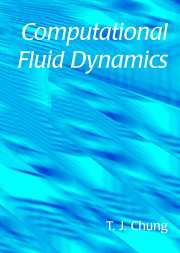Book contents
- Frontmatter
- Contents
- Preface
- PART ONE PRELIMINARIES
- PART TWO FINITE DIFFERENCE METHODS
- PART THREE FINITE ELEMENT METHODS
- 8 Introduction to Finite Element Methods
- 9 Finite Element Interpolation Functions
- 10 Linear Problems
- 11 Nonlinear Problems/Convection-Dominated Flows
- 12 Incompressible Viscous Flows via Finite Element Methods
- 13 Compressible Flows via Finite Element Methods
- 14 Miscellaneous Weighted Residual Methods
- 15 Finite Volume Methods via Finite Element Methods
- 16 Relationships between Finite Differences and Finite Elements and Other Methods
- PART FOUR FOUR. AUTOMATIC GRID GENERATION, ADAPTIVE METHODS, AND COMPUTING TECHNIQUES
- PART FIVE APPLICATIONS
- APPENDIXES
- Index
14 - Miscellaneous Weighted Residual Methods
Published online by Cambridge University Press: 15 January 2010
- Frontmatter
- Contents
- Preface
- PART ONE PRELIMINARIES
- PART TWO FINITE DIFFERENCE METHODS
- PART THREE FINITE ELEMENT METHODS
- 8 Introduction to Finite Element Methods
- 9 Finite Element Interpolation Functions
- 10 Linear Problems
- 11 Nonlinear Problems/Convection-Dominated Flows
- 12 Incompressible Viscous Flows via Finite Element Methods
- 13 Compressible Flows via Finite Element Methods
- 14 Miscellaneous Weighted Residual Methods
- 15 Finite Volume Methods via Finite Element Methods
- 16 Relationships between Finite Differences and Finite Elements and Other Methods
- PART FOUR FOUR. AUTOMATIC GRID GENERATION, ADAPTIVE METHODS, AND COMPUTING TECHNIQUES
- PART FIVE APPLICATIONS
- APPENDIXES
- Index
Summary
In the previous chapters, with an exception of GPG, the finite element formulations are based on the Galerkin methods in which test functions are chosen to be the same as the trial functions. This is not required in the weighted residual methods.
Weighted residual methods other than the Galerkin methods include spectral element methods (SEM), least square methods (LSM), moment methods, or collocation methods, in which the test functions or weighting functions are not necessarily the same as the trial functions. In spectral element methods (SEM), polynomials in terms of nodal values of the variables are combined with special functions such as Chebyshev or Legendre polynomials. For least square methods, the test functions are constructed by the derivative of the residual with respect to the nodal values of the variables. Some arbitrary functions are chosen as test functions for the moment and collocation methods. Recently, the weighted residual concept has been used in meshless configurations, known as the finite point method (FPM), partition of unity method, meshless cloud method, or element-free method.
In the following sections, we shall describe a certain type of spectral element methods, least square methods, optimal control methods (OCM), and finite point methods (FPM). They are selected here for discussion because of their possible future potential for further developments.
SPECTRAL ELEMENT METHODS
The term “spectral” as used here implies a special function. Examples of such functions may be Chebyshev, Legendre, or Laguerre polynomials. These functions are expected to portray physical phenomena more realistically and precisely than other functions that have been discussed previously, leading to a greater solution accuracy. However, their applications are limited to simple geometries and simple boundary conditions.
Information
- Type
- Chapter
- Information
- Computational Fluid Dynamics , pp. 462 - 490Publisher: Cambridge University PressPrint publication year: 2002
